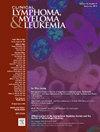SOHO State of the Art Updates and Next Questions | Latest Advances in the Management of Primary Mediastinal B-Cell Lymphoma
IF 2.7
4区 医学
Q2 HEMATOLOGY
引用次数: 0
Abstract
Primary mediastinal B-cell lymphoma (PMBCL) is recognized as a distinct clinicopathologic entity that predominantly affects adolescents and young adults (AYA) and is more common in females. Although PMBCL was previously considered to be a subtype of diffuse large B-cell lymphoma, the clinical, histological, and biological characteristics overlap significantly with those of nodular-sclerosing Hodgkin lymphoma (NS-HL). Over recent years, the shared biology of these 2 entities has been highlighted in several studies, and mediastinal gray zone lymphoma, with features intermediate between PMBCL and NS-HL, has been recognized as a unique molecular entity. Although there is a lack of consensus about the optimal therapeutic strategy for patients with newly diagnosed PMCBL, highly curative treatment regimens that obviate the need for mediastinal radiation therapy (RT) are favored by most. Recently, the results from IELSG-37 were presented and demonstrated that patients with a negative PET/CT scan at the completion of treatment do not require consolidative RT. Progress in understanding the biology of PMBCL and its close relationship to NS-HL have helped pave the way for the investigation of novel strategies, including immune checkpoint inhibitors (ICI), CD30-targeting agents and adoptive T-cell approaches. Currently, a clinic trial is ongoing that is evaluating the role of nivolumab with chemo-immunotherapy for the frontline treatment of PMBCL, after ICI have shown robust responses in patients with relapsed and refractory (R/R) PMBCL. In the R/R setting, studies with anti-CD19 CAR-T-cell therapies and treatments with bispecific antibodies have shown good activity.
原发性纵隔b细胞淋巴瘤治疗的最新进展。
原发性纵隔b细胞淋巴瘤(PMBCL)被认为是一种独特的临床病理实体,主要影响青少年和年轻人(AYA),在女性中更常见。虽然PMBCL以前被认为是弥漫性大b细胞淋巴瘤的一种亚型,但其临床、组织学和生物学特征与结节硬化霍奇金淋巴瘤(NS-HL)有显著的重叠。近年来,这两种实体的共同生物学特性在一些研究中得到了强调,具有介于PMBCL和NS-HL之间特征的纵隔灰色地带淋巴瘤被认为是一种独特的分子实体。尽管对于新诊断的PMCBL患者的最佳治疗策略缺乏共识,但大多数人都赞成避免纵隔放射治疗(RT)的高治疗法。最近,IELSG-37的结果显示,在治疗完成时PET/CT扫描阴性的患者不需要巩固性rt。了解PMBCL的生物学及其与nshl的密切关系的进展有助于为研究新的策略铺平道路,包括免疫检查点抑制剂(ICI), cd30靶向药物和过继t细胞方法。目前,一项正在进行的临床试验正在评估nivolumab与化学免疫疗法在PMBCL一线治疗中的作用,ICI在复发和难治性(R/R) PMBCL患者中显示出强劲的反应。在R/R环境中,抗cd19 car - t细胞疗法和双特异性抗体治疗的研究显示出良好的活性。
本文章由计算机程序翻译,如有差异,请以英文原文为准。
求助全文
约1分钟内获得全文
求助全文
来源期刊

Clinical Lymphoma, Myeloma & Leukemia
ONCOLOGY-HEMATOLOGY
CiteScore
2.70
自引率
3.70%
发文量
1606
审稿时长
26 days
期刊介绍:
Clinical Lymphoma, Myeloma & Leukemia is a peer-reviewed monthly journal that publishes original articles describing various aspects of clinical and translational research of lymphoma, myeloma and leukemia. Clinical Lymphoma, Myeloma & Leukemia is devoted to articles on detection, diagnosis, prevention, and treatment of lymphoma, myeloma, leukemia and related disorders including macroglobulinemia, amyloidosis, and plasma-cell dyscrasias. The main emphasis is on recent scientific developments in all areas related to lymphoma, myeloma and leukemia. Specific areas of interest include clinical research and mechanistic approaches; drug sensitivity and resistance; gene and antisense therapy; pathology, markers, and prognostic indicators; chemoprevention strategies; multimodality therapy; and integration of various approaches.
 求助内容:
求助内容: 应助结果提醒方式:
应助结果提醒方式:


